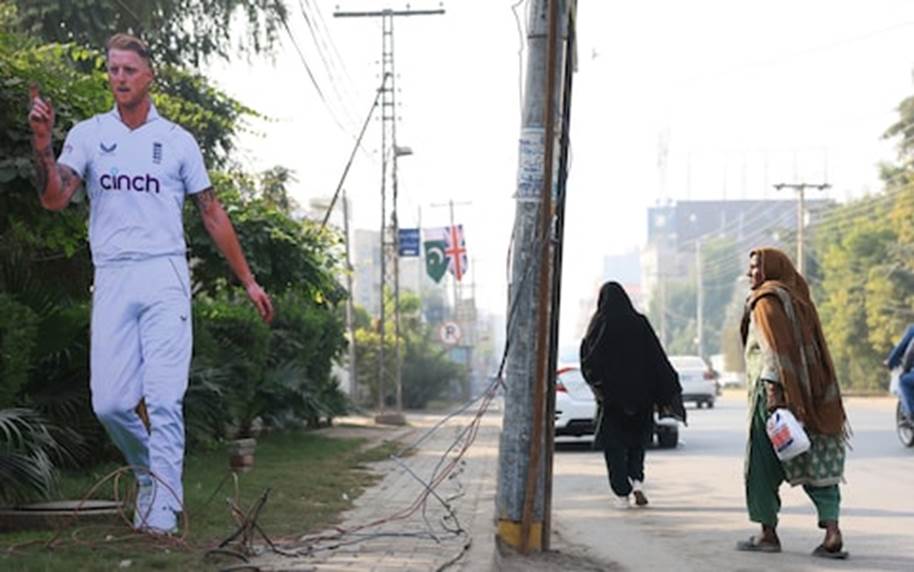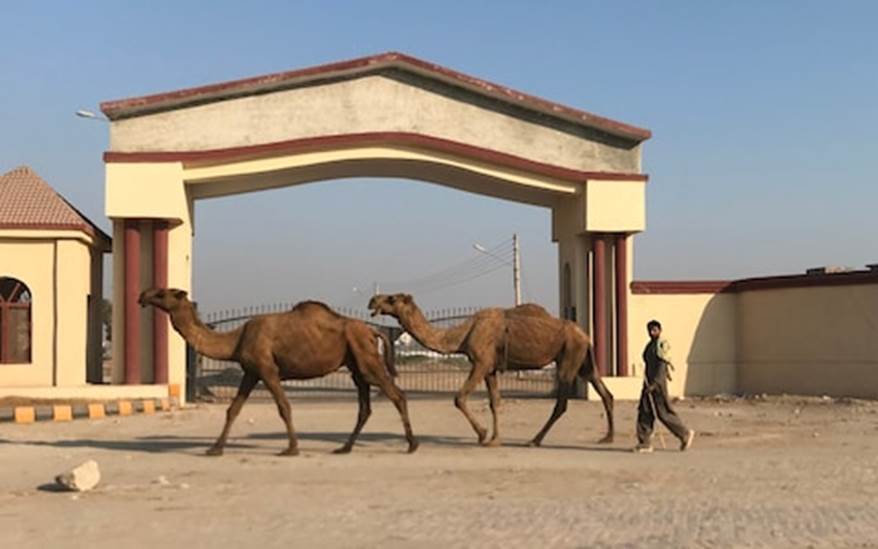
Ben Stokes: the main attraction (even in cardboard) - Matthew Lewis/Getty
The Barmy Army and Life on Tour in Pakistan
By Nick Hoult
“How have you enjoyed the food in Karachi?” It was an odd question to end Ben Stokes’ final press conference but at least the Pakistani journalist asking it did more than his team to make the England captain think twice.
Stokes replied politely, after a pause for thought saying “we had our own chef” and throughout the two tours – the Twenty20 series in September and this one – England have not put a foot wrong on the field or off it in a country that was a mystery to most of them.
From the cardboard cutouts of Stokes in Karachi, Multan and Rawalpindi, to the adverts for the series on the back of tuk-tuks, Pakistan has taken this England tour to its heart. The welcome has been warm and generous, the crowds fair in their support of both teams and it was played in a spirit of friendship and fair play.
The small band of England travelling supporters stop and tell you about how receptive people have been, the number of times they have been asked for selfies, the ease of getting into grounds and feeling of being part of the spectacle.
Few mention security concerns or the lack of a drink. The England caravan is unique. No other team attracts a sizeable away following for Test cricket and they could be a valuable source of income for Pakistan in years to come. Bridges have been built.
There are challenges, and it would be wrong to paint this as an easy trip. It has not been a long tour, just 25 days, but it has been the most intense I have experienced, including away Ashes series. Day-to-day tasks take more thought than anywhere else, one slip can cause illness, the traffic, pollution and smog exacerbated the lurgy that lingered.
Escaping from the cricket bubble was difficult – and impossible in Multan. It was easier in Karachi but social life in Islamabad was restricted to a British High Commission bash and a Pakistan Cricket Board trip into the Margalla Hills for an unforgettable media dinner.
Those who travelled to Multan will never forget the experience, and not always for the right reasons. The seven-hour road trip from Islamabad cutting through the Salt Range mountains before giving way to the flat orange and mango groves of the Punjab was more enjoyable than the endless flights of an Ashes tour.

A street scene in Multan
But Multan was the hardest week any England player or fan has experienced. Previous generations had it tougher with fewer comforts but did not experience the same security levels.
Illness was rampant in the team and among supporters. Westerners could not leave hotels barricaded with razor wire without an armed guard, even to walk to a restaurant next door. Security men would refuse to unbolt the gates if you were unaccompanied. Multan could not really cope with the influx of fans, or the traffic chaos caused by road closures for the team convoys.
The players enjoyed a day at the Rumanza championship golf course and some tour groups made the most of pre-tour bookings at restaurants, but nobody had been made aware of the security restrictions before arrival and that grated with some.
At least by ending in four days it allowed time for a city tour: magnificent Sufi shrines, the chaotic fun of the local bazaar and a trip to see the crumbling old ground in the city center that hosted one Test in 1980 (famous for Sylvester Clarke clobbering a fan with a brick). Inevitably it was filled with young kids belting a tennis ball with a plank of wood.
Karachi was like visiting another country. The Movenpick hotel bar, legal in high end hotels, ran out of Heineken within 30 minutes of thirsty England fans arriving - despite them costing £15 a can. They didn’t make that mistake again.
From the shopping malls, high-end restaurants and sense of freedom to the hospitality of locals who welcomed us into their homes, keen to talk cricket but also to show off a different side to their country and break down myths about Pakistan, it felt like a city you want to explore again.
Thanks to Sharmeen Obaid Chinoy, double Oscar-winning director, who opened her home to the travelling media and let hacks get their hands on her Academy Awards (surprisingly heavy).
The third Test ended with a presentation from the Sports Journalists Association of Sindh with Ajraks (shawls) and Topi hats to the travelling press, as well as a tour of the historic Karachi Press Club where there was a political demonstration outside but barely anyone bothered to notice, too busy talking about cricket.

The travelling cricket press after the Ajrak presentation
The team chef was a hit with the players and many say he was the hardest working man on tour, up early to scrub kitchens and ensure the highest standard of food hygiene. It is a fact, smugly noted by the press, that more players were ill than the media.
The tour started in the shadow of Imran Khan’s march on Rawalpindi which briefly threatened an itinerary change but by the time of the third Test in Karachi security was noticeably more relaxed. It has to be for the long term. The PCB cannot survive paying £2m for presidential levels of security for each tour. They lose money on Test tours anyway. To make the sport sustainable it needs to wash its face financially.
Many supporters told me they look forward to coming back, sampling it all again and hope there will be fewer gun-toting cops and more local fans at the grounds. One group trooped off to the Karachi Gymkhana when the third Test finished early to watch more cricket, and be welcomed again. Pakistan is a tour like no other. It feels like it is back now, 17 years of absence are over. Cricket is better for it. – The Telegraph

